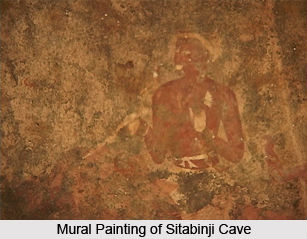 Ravana Chhaya, a rock shelter near Sitabinji, Orissa, is around 1,300 - 1,500 years old and contains ancient painting created in the tempera method. Sitabinji is a rural community that has an interesting past and was named after the stream Sita that flows near the region.
Ravana Chhaya, a rock shelter near Sitabinji, Orissa, is around 1,300 - 1,500 years old and contains ancient painting created in the tempera method. Sitabinji is a rural community that has an interesting past and was named after the stream Sita that flows near the region.
There is a crevice in between two rock boulders that consists of exquisite tempera art and painting that can be traced back to the 7th century. The art work is not linked with any religious beliefs and depicts the scene of a royal procession. Ravana Chhaya can be literally translated into Shadow of Ravana, the King of Lanka (as mentioned in Ramayana).
The Ravana Chhaya rock shelters are situated between two massive boulders of granite. The larger boulder is inclined towards the smaller boulder, which creates a triangular crevice in between. The gap is around 6.7 m in height and 4.7 m in depth. The depth of the crevice has provided favourable conditions for the preservation of the precious artwork.
History of Ravana Chhaya
The cave had adequate significance in the ancient times, even in the period before the artwork was created. Followers of Lord Shiva used the cave around 4th - 6th century AD. They used to worship Mukha Linga, a depiction of lingam with four faces of lord Shiva and are still situated in the Sitabinji region. The inscriptions in the nearby areas also depict the Mukha Linga which provides evidence that worship of Shiva was hugely popular in Orissa during the 5th century AD.
There are also remnants in the vicinity that contain pieces of ancient bricks and inscriptions in Pali language. More over ancient coins of the Kushanas and other sculptures have also been excavated, which suggest that Sitabinji was widely popular in those days. Other rock cut shelters in the area contain paintings and artworks from the Mesolithic period, which are also popular as Paintings of Sitabinji.
Tempera Paintings of Ravana Chhaya
The painting of Ravana Chhaya rock shelters, which was created in the tempera technique, was brilliant in terms of quality and skill, dates back to 7th Century AD. The granite surface, which is usually rough, was smoothened by using a thin layer of lime, before applying the quick drying colours that was used in tempera paintings. The painting appears to have resemblance with the styles adopted in artworks of Hindu religion. It portrayed an imperial figure sitting on top of an elephant and holding a sword, in a royal procession. A number of followers escort the procession on foot, along with women who seem to be dancing and a few horsemen. It is believed by experts that the location was used as a royal retreat while hunting.
The name of Maharaja Sri Disabhanja also appears in the lines below the painting. It was writing was painted in the Sanskrit language in the 7th century AD. Furthermore, to protect and conserve the artwork from seeping water, a channel has been chiselled on the rocks, right above the artwork. But still the lower portion of the painting has eroded.



















